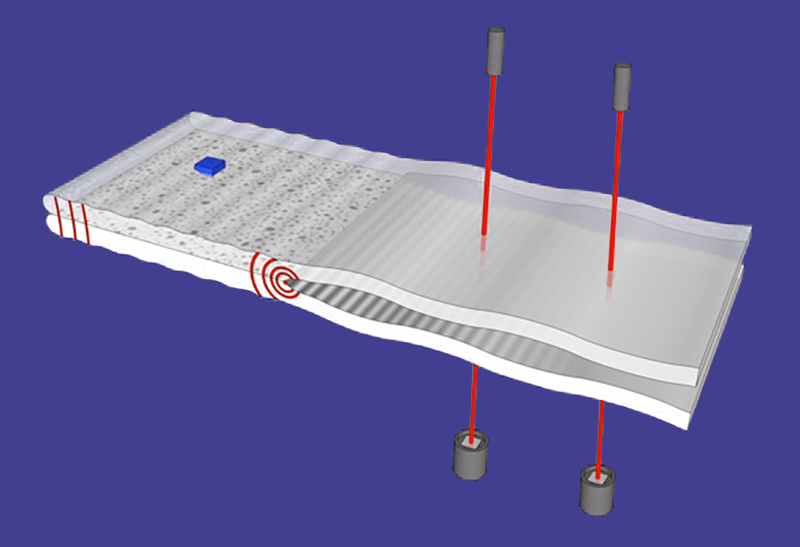How Cracks Interact with the Sounds They Make
A crack ripping through a material is usually accompanied by a snapping sound. The snap is produced by sound waves within the material that can also interact with the crack, and now researchers have demonstrated that this interaction can control the patterns left behind on the newly-created surfaces. The finding may help engineers improve the fabrication of silicon-on-insulator (SOI) electronics, a technology widely used in smartphones. More generally, it may allow researchers to better control the results of material fractures.
In SOI devices, there is an insulating layer of silicon oxide separating the pure silicon top layer from the rest of the silicon wafer. The insulating layer reduces current leaks, leading to devices that are more power-efficient and faster than conventional silicon chips. A common SOI fabrication procedure includes a step in which a crack is generated that slices through the wafer parallel to, but at some distance below, the insulating layer. To guide this crack, engineers first produce a thin layer of tiny cavities by implanting ions into the wafer at the desired depth.
The crack can leave periodic patterns on the newly exposed surfaces in which a rougher texture alternates with a smoother texture. Such inhomogeneities can be detrimental to circuit performance. Francois Rieutord of Grenoble Alpes University, France, and the French Alternative Energies and Atomic Energy Commission (CEA) and his team set out to understand the origin of these patterns, hoping to find ways to suppress them. “When we looked at images of the post-fracture wafer surfaces,” says Rieutord, “we saw patterns similar to the waves left in the wake of a moving boat.” This similarity led the researchers to consider the sound waves launched—a bit like a wake—by the propagating crack, although it wasn’t clear how these waves would lead to the observed periodicity of the roughness pattern.
To decipher the mechanisms, the researchers deployed a setup they previously developed. In their experiments, a blade triggered the propagation of a crack through a silicon wafer, and lasers measured the arrival of the crack front at two locations, determining a propagation speed of about 2.5 km/s. Simultaneously, piezoelectric sensors on the top and bottom of the wafer detected the surface deformations caused by acoustic waves. The team could distinguish between two kinds of waves: symmetric waves, in which the movements of the top and bottom surfaces mirror one another, and antisymmetric, “flexural” waves, where the two surfaces bend as one unit with a fixed thickness.
The experiments allowed the team to pinpoint the dominant mechanism of crack-wave interaction. According to their data, as the crack starts, it emits symmetric and antisymmetric acoustic waves with a wide range of frequencies, each having a different velocity. Through a resonance phenomenon associated with the crack propagation speed, the moving crack front selectively amplifies antisymmetric waves known as Lamb flexural waves that propagate forward at about twice the crack’s speed. These waves reverse direction when they are reflected from the wafer boundary, and then they collide head-on with the crack front. The crack is guided by the plane of tiny cavities produced in advance with ion implantation, but for microscopic distances between these cavities, the crack deviates slightly from this plane. The amount of deviation is strongly affected by the periodic deformations produced in the material as the Lamb waves move through, which leads to the periodic roughness variations.
Using a simple model, Rieutord and his colleagues predicted that these crack deviations should lead to a pattern of roughness variation with a period of half the wavelength of the Lamb waves. This prediction agreed with observations of post-fracture samples, and the team says that this agreement provides strong support for their explanation of the roughness patterns.
While motivated by SOI applications, the study may be relevant for a broad class of materials, says Jay Fineberg of the Hebrew University of Jerusalem. “The authors were able to clearly pinpoint a never-before-considered mechanism by which a crack can modulate itself as it propagates in a crystal,” he says. Fineberg believes that the phenomenon could be harnessed in other situations where researchers need to control the surface patterns left over by the cleavage of crystalline materials.
This research is published in Physical Review Letters.
–Matteo Rini
Matteo Rini is the Editor of Physics Magazine.





